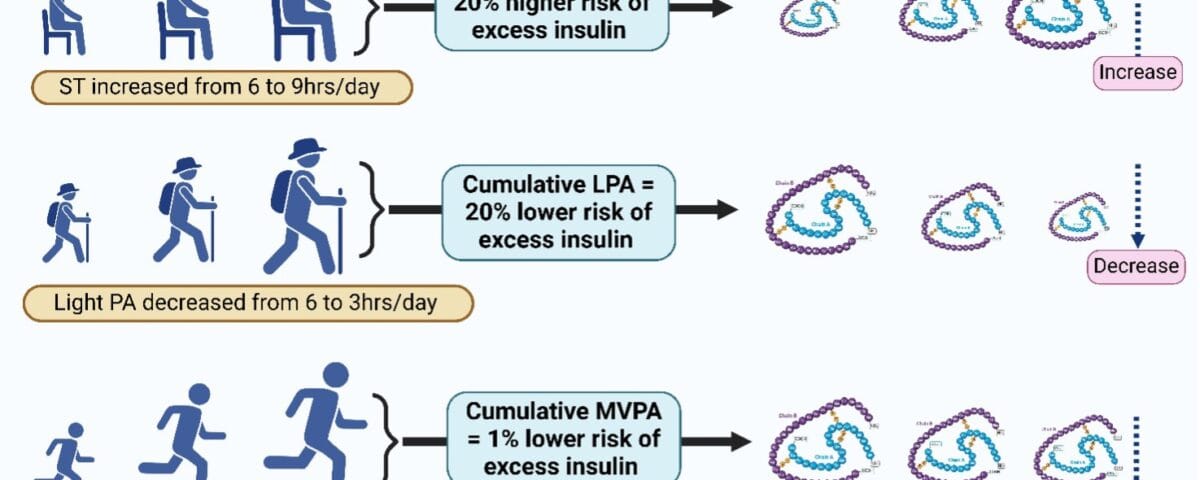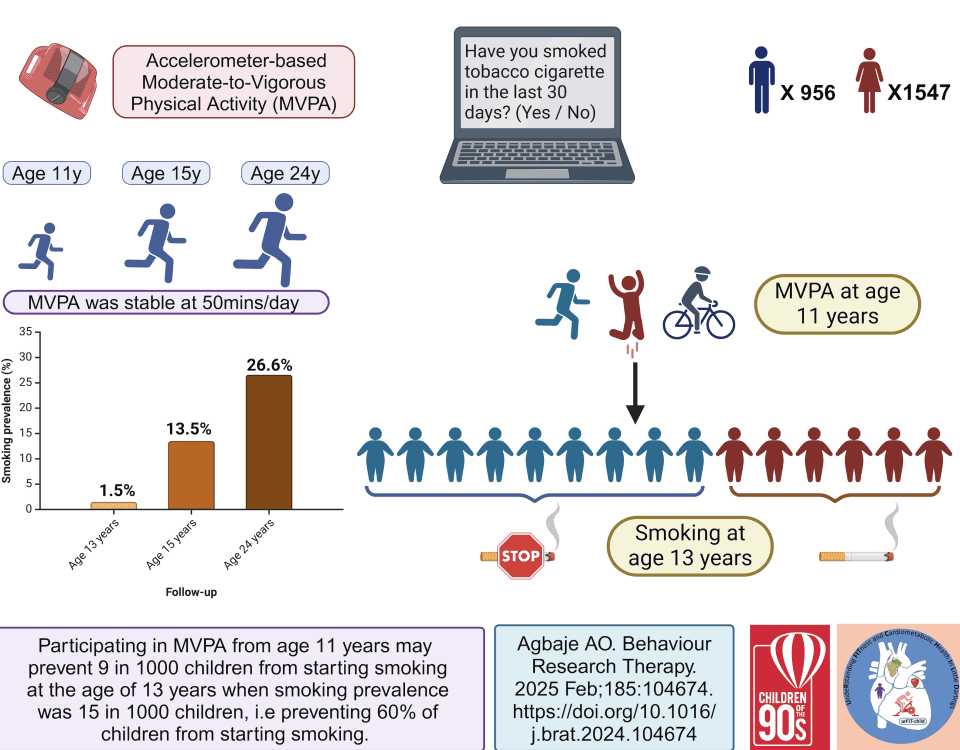
A Behaviour Change Intervention to Reduce Sedentary Behaviour in Chronic Obstructive Pulmonary Disease: A Qualitative Study
April 26, 2024
The impact of the world’s first regulatory, multi-setting intervention on sedentary behaviour among children and adolescents (ENERGISE): a natural experiment evaluation
May 16, 2024Congratulations to Dr. Andrew Agbaje and colleagues for their new publication entitled “The Interactive Effects of Sedentary Time, Physical Activity, and Fat Mass on Insulin Resistance in the Young Population”. A big thank you also goes to Dr. Andrew Agbaje who provided this blog post. This press release was originally published by the University of Eastern Finland which can be found here. Full link to the article can be found here.
An increase in sedentary time from childhood is associated with a significant increase in blood insulin concentration, a new study shows. However, light physical activity could reduce the risk of excess insulin and insulin resistance. The study was conducted in collaboration between the Universities of Bristol and Exeter, and the University of Eastern Finland, and the results were published in the Journal of Clinical Endocrinology and Metabolism.
Based on the University of Bristol’s Children of the 90s data, the study included 792 children followed up from 11 to 24 years of age. At baseline they spent an average of 6 hours per day in sedentary activities, which increased to 9 hours per day during the follow-up. This increase in sedentary time was associated with continuously higher insulin levels in fasting blood, especially among youths with overweight and obesity, whose risk of excess insulin increased by 20%. On the contrary, an average of light physical activity (LPA) of 3-4 hours per day throughout the follow-up decreased the risk of excess insulin by 20%. Higher LPA was also associated with lower insulin resistance.
Participating in moderate-to-vigorous physical activity (MVPA) showed signs of reducing insulin but to a much smaller extent.
Earlier results from the same cohort have linked sedentariness to fat obesity, dyslipidaemia, inflammation, and premature vascular damage. The researchers have also observed a vicious cycle of obesity and worsening insulin resistance.
Light physical activity is now emerging as an effective approach to reversing the deleterious effect of childhood sedentariness. However, whether long-term exposure to LPA from childhood reduces excess glucose, insulin, and insulin resistance has not been examined before. This is because only a few studies have repeatedly measured all these in a large population of healthy youth.
The current study is the largest and the longest follow-up accelerometer-measured movement behaviour and glucose, insulin, and insulin resistance study in the world. The participants wore accelerometer devices on their waists at ages 11, 15, and 24 years for 4–7 days and had fasting glucose and insulin measurements at ages 15, 17, and 24 years. Their fasting blood samples were also repeatedly measured for high-density lipoprotein cholesterol, low-density lipoprotein cholesterol, triglycerides, and high-sensitivity C-reactive protein. Blood pressure, heart rate, smoking status, socio-economic status, and family history of cardiovascular disease were controlled for in the analyses.
“Calling a spade a spade, our recent studies have identified childhood sedentariness as a monster that threatens the young population across the globe, no thanks to excessive screen use, “ says Andrew Agbaje, an award-winning physician and professor (associate) of clinical epidemiology and child health at the University of Eastern Finland.
“Sedentariness should be recognised as one of the twenty-first century independent causes of excess insulin, fat obesity, high lipid levels, inflammation, and arterial stiffness. 3–4 hours of LPA per day is critically important to antagonising childhood sedentariness. While we await the update of the current World Health Organization’s physical activity guideline, which does not include an LPA recommendation, public health experts, health policymakers, health journalists, paediatricians, and parents should encourage kids to participate in LPA daily.”
Prof. Agbaje’s research group (urFIT-child) is supported by research grants from Jenny and Antti Wihuri Foundation, the Finnish Cultural Foundation Central Fund, the Finnish Cultural Foundation North Savo Regional Fund, the Orion Research Foundation, the Aarne Koskelo Foundation, the Antti and Tyyne Soininen Foundation, the Paulo Foundation, the Yrjö Jahnsson Foundation, the Paavo Nurmi Foundation, the Finnish Foundation for Cardiovascular Research, Ida Montin Foundation, Eino Räsänen Fund, Matti and Vappu Maukonen Fund, Foundation for Pediatric Research, and Alfred Kordelin Foundation.
In 792 children followed up from age 11 to 24 years, increased sedentariness from childhood through young adulthood worsened insulin concentration, especially in children and adolescents with overweight and obesity. Light physical activity reduced excessive insulin and lowered insulin resistance. Image: Andrew Agbaje.
For further information, please contact:
Andrew Agbaje, MD, MPH, PhD, FESC, FAHA, Cert. Clinical Research (Harvard), Professor (associate) of Clinical Epidemiology and Child Health, Principal Investigator (urFIT-child). Institute of Public Health and Clinical Nutrition, School of Medicine, University of Eastern Finland, Kuopio, Finland. andrew.agbaje(a)uef.fi, +358 46 896 5633
Honorary Research Fellow – Children’s Health and Exercise Research Centre, Public Health and Sports Sciences Department, Faculty of Health and Life Sciences, University of Exeter, Exeter, UK. a.agbaje@exeter.ac.uk
https://uefconnect.uef.fi/en/person/andrew.agbaje/
Webpage:
Link to the articles:
Agbaje AO. The Interactive Effects of Sedentary Time, Physical Activity, and Fat Mass on Insulin Resistance in the Young Population. J Clin Endocrinol Metab. 2024 Mar 5:dgae135. https://doi.org/10.1210/clinem/dgae135
About Children of the 90s
Based at the University of Bristol, Children of the 90s, also known as the Avon Longitudinal Study of Parents and Children (ALSPAC), is a long-term health research project that enrolled more than 14,000 pregnant women in 1991 and 1992. It has been following the health and development of the parents, their children and now their grandchildren in detail ever since. It receives core funding from the Medical Research Council, the Wellcome Trust and the University of Bristol.
About the University of Eastern Finland
The University of Eastern Finland, UEF, is the most multidisciplinary university in Finland. The university’s high standard of interdisciplinary research and education responds to global challenges, building a sustainable future. Research conducted at UEF is ranked among the best in the world in several fields. The university is home to 16,000 students and 3,200 staff.




